Anfänger fragen uns oft nach der Umstellung ihrer Websites auf SSL oder HTTPS. Die Begriffe klingen vielleicht zu technisch, aber es ist eigentlich sehr einfach.
HTTPS in der URL einer Website bedeutet, dass sie ein sicheres Datenübertragungsprotokoll verwendet, indem sie ein SSL-Zertifikat installiert hat. Dies ist wichtig, weil die meisten modernen Browser Warnungen für Websites anzeigen, die kein HTTPS verwenden.
Glücklicherweise machen es die meisten zuverlässigen Hosting-Unternehmen und WordPress sehr einfach, Ihre Website zu sichern.
In diesem Artikel zeigen wir Ihnen, wie Sie Ihr WordPress von HTTP auf HTTPS umstellen, indem Sie ein SSL-Zertifikat hinzufügen. Machen Sie sich keine Sorgen, wenn Sie nicht wissen, was SSL oder HTTPS ist. Auch das werden wir Ihnen erklären.
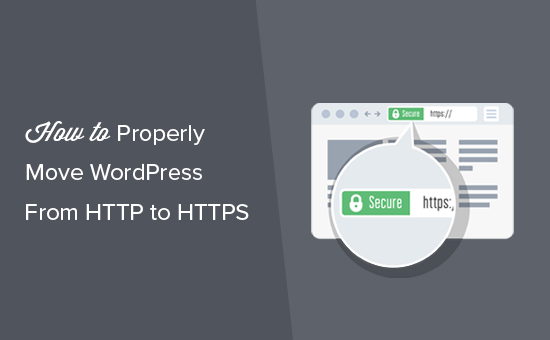
Hier ist ein kurzer Überblick über die Themen, die wir in diesem Artikel behandeln werden:
- What Is HTTPS?
- Why Do You Need HTTPS and SSL?
- Requirements for Using HTTPS/SSL on a WordPress Site
- Setting Up WordPress to Use SSL and HTTPS
- Method 1: Setup SSL/HTTPS in WordPress Using a Plugin
- Method 2: Set Up SSL/HTTPS in WordPress Manually
- Submit Your HTTPS Site to Google Search Console
- Bonus Resources
- Video Tutorial
Was ist HTTPS?
HTTPS oder Secure HTTP ist eine Verschlüsselungsmethode, die die Verbindung zwischen dem Browser eines Benutzers und Ihrem Server sichert. Diese zusätzliche Sicherheit macht es für Hacker viel schwieriger, die übertragenen Daten abzufangen.
Jeden Tag geben Menschen persönliche Daten an Websites weiter, sei es beim Einkaufen oder einfach nur beim Einloggen. Wir haben aus erster Hand erfahren, wie wichtig es ist, diese Art von Datenaustausch zu schützen.
Um die Datensicherheit zu gewährleisten, muss eine sichere Verbindung hergestellt werden.
An dieser Stelle kommen SSL und HTTPS ins Spiel.
Jede Website erhält zur Identifizierung ein eindeutiges SSL-Zertifikat. Wenn ein Server versucht, HTTPS ohne gültiges Zertifikat zu verwenden oder wenn das Zertifikat nicht übereinstimmt, warnen die meisten modernen Browser die Benutzer und raten ihnen, nicht fortzufahren.
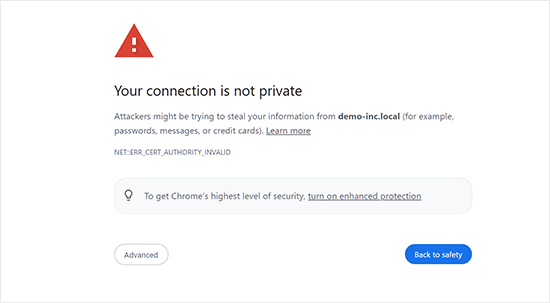
Sie fragen sich vielleicht, warum Sie Ihre WordPress-Website von HTTP auf HTTPS umstellen müssen, vor allem, wenn es sich um einen einfachen Blog oder eine kleine Unternehmenswebsite handelt, auf der keine Zahlungen abgewickelt werden.
Warum brauchen Sie HTTPS und SSL?
Im Jahr 2018 kündigte Google eine Initiative zur Erhöhung der Websicherheit an und forderte die Betreiber von Websites auf, von HTTP auf HTTPS umzustellen. Um diesen Schritt zu unterstützen, begann der Chrome-Browser, alle Websites ohne SSL-Zertifikat als “nicht sicher” zu kennzeichnen.
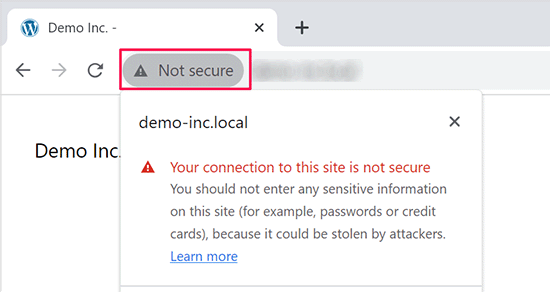
Google erwähnte auch, dass Websites mit SSL Vorteile für die Suchmaschinenoptimierung hätten und höhere Suchergebnisse erzielen könnten als nicht gesicherte Websites. Diese Ankündigung veranlasste viele Website-Besitzer, zu HTTPS zu wechseln.
Nach der Einführung der Warnung “Nicht sicher” begann Chrome, HTTP-Websites zu markieren. Der Besuch einer HTTP-Site im Inkognito-Modus oder das Ausfüllen eines Kontaktformulars auf einer HTTP-Site löst die Warnung aus und kennzeichnet sie als unsicher.
Wenn Besucher diese Warnung sehen, kann das einen negativen Eindruck von Ihrer Website oder Ihrem Unternehmen hinterlassen.
Aus diesem Grund müssen alle Websites so schnell wie möglich auf HTTPS umstellen und SSL installieren.
Außerdem ist SSL ein Muss, wenn Sie Online-Zahlungen auf Ihrer eCommerce-Website akzeptieren möchten.
Zahlungsanbieter wie Stripe, PayPal Pro und Authorize.Net benötigen eine sichere Zahlungsverbindung.
Wir stellen sicher, dass unsere eigenen Websites SSL verwenden, einschließlich WPBeginner, OptinMonster, WPForms und MonsterInsights.
Erfordernisse für die Verwendung von HTTPS/SSL auf einer WordPress Website
Die Anforderungen für die Verwendung von SSL in WordPress sind nicht sehr hoch. Sie müssen lediglich ein SSL-Zertifikat erwerben, und vielleicht haben Sie es bereits kostenlos.
Die besten WordPress-Hosting-Unternehmen bieten kostenlose SSL-Zertifikate für alle ihre Nutzer an:
Weitere Einzelheiten finden Sie in unserem Leitfaden zum Erhalt eines kostenlosen SSL-Zertifikats für Ihre WordPress-Website.
Wenn Ihr Hosting-Unternehmen kein kostenloses SSL-Zertifikat anbietet, müssen Sie eines erwerben.
Wir empfehlen Domain.com, weil es das beste SSL-Angebot für reguläre und Wildcard-SSL-Zertifikate bietet.
Mit dem Kauf eines SSL-Zertifikats erhalten Sie auch ein TrustLogo-Siegel für Ihre Website. Jedes SSL-Zertifikat wird mit einer Sicherheitsgarantie von mindestens 10.000 $ geliefert. Die Preise beginnen bei 33 $ pro Jahr, und SSL-Zertifikate werden automatisch erneuert.
Sobald Sie ein SSL-Zertifikat erworben haben, müssen Sie Ihren Hosting-Anbieter bitten, es für Sie zu installieren.
Benötigen Sie Hilfe bei der Einrichtung von SSL und der Umstellung auf HTTPS?
Wenn Sie keine Zeit haben, SSL einzurichten, ist unser Premium-WordPress-Support-Service da, um zu helfen! Wir können den gesamten Prozess für Sie übernehmen und dafür sorgen, dass Ihre Website sicher und bereit für Besucher ist.
- Einmalige Gebühr
- Schnelle Durchlaufzeiten
- 24/7 auf Abruf verfügbar
Sie können beruhigt sein, denn Ihre Website ist in den Händen von Experten. Kontaktieren Sie uns noch heute für eine reibungslose SSL-Installation und HTTPS-Migration!
Einrichten von WordPress zur Verwendung von SSL und HTTPS
Nachdem Sie ein SSL-Zertifikat für Ihren Domainnamen aktiviert haben, müssen Sie WordPress so einrichten, dass es SSL- und HTTP-Protokolle auf Ihrer Website verwendet.
Wir zeigen Ihnen zwei Methoden, und Sie können diejenige wählen, die Ihren Bedürfnissen am besten entspricht.
Methode 1: Einrichten von SSL/HTTPS in WordPress mithilfe eines Plugins
Diese Methode ist einfacher und wird für Anfänger empfohlen.
Zunächst müssen Sie das Really Simple SSL-Plugin installieren und aktivieren. Weitere Einzelheiten finden Sie in unserer Schritt-für-Schritt-Anleitung zur Installation eines WordPress-Plugins.
Nach der Aktivierung müssen Sie die Seite Einstellungen ” SSL aufrufen. Das Plugin erkennt automatisch Ihr SSL-Zertifikat und richtet Ihre WordPress-Website für die Verwendung von HTTPS ein.
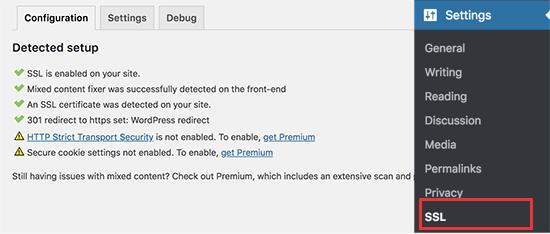
Das Plugin kümmert sich um alles, auch um die Fehler bei gemischten Inhalten. Hier ist, was das Plugin hinter den Kulissen tut:
- SSL-Zertifikat prüfen
- WordPress so einstellen, dass https in URLs verwendet wird
- Umleitungen von HTTP zu HTTPS einrichten
- Suchen Sie nach URLs in Ihren Inhalten, die noch von unsicheren HTTP-Quellen geladen werden, und versuchen Sie, diese zu korrigieren.
Hinweis: Das Plugin versucht, Fehler bei gemischten Inhalten zu beheben, indem es eine Ausgabepufferungstechnik verwendet. Dies kann sich negativ auf die Leistung auswirken, da Inhalte auf der Website ersetzt werden, während die Seite geladen wird. Diese Auswirkung ist nur beim ersten Laden der Seite zu sehen und sollte minimal sein, wenn Sie ein Caching-Plugin verwenden.
Das Plugin sagt zwar, dass Sie SSL beibehalten und das Plugin sicher deaktivieren können, aber das ist nicht zu 100 % wahr. Sie müssen das Plugin immer aktiv lassen, da die Deaktivierung des Plugins zu Fehlern bei gemischten Inhalten führt. Weitere Einzelheiten finden Sie in unserer Really Simple SSL-Bewertung.
Methode 2: Manuelles Einrichten von SSL/HTTPS in WordPress
Diese Methode erfordert eine manuelle Problembehandlung und die Bearbeitung von WordPress-Dateien. Es ist jedoch eine dauerhafte und leistungsoptimierte Lösung, die wir bei WPBeginner verwenden.
Wenn Sie diese Methode für schwierig halten, sollten Sie einen WordPress-Entwickler beauftragen oder stattdessen die erste Methode anwenden.
Möglicherweise müssen Sie das WordPress-Theme und die Codedateien im Rahmen dieser Methode bearbeiten. Wenn Sie dies noch nicht getan haben, lesen Sie unsere Anleitung zum Kopieren und Einfügen von Codeschnipseln in WordPress.
Zuerst müssen Sie die Seite Einstellungen ” Allgemein aufrufen. Hier müssen Sie Ihre WordPress- und Website-URL-Adressfelder aktualisieren, indem Sie http durch https ersetzen.
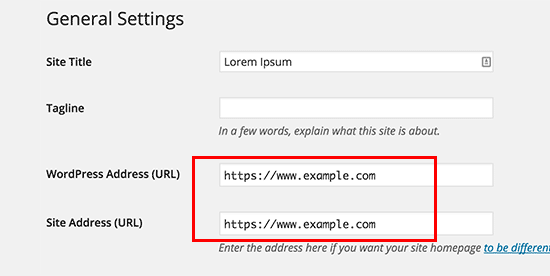
Vergessen Sie nicht, auf die Schaltfläche “Änderungen speichern” zu klicken, um Ihre Einstellungen zu speichern.
Sobald die Einstellungen gespeichert sind, meldet WordPress Sie ab und Sie werden aufgefordert, sich erneut anzumelden.
Als Nächstes müssen Sie WordPress-Umleitungen von HTTP zu HTTPS einrichten, indem Sie den folgenden Code in Ihre .htaccess-Datei einfügen:
1 2 3 4 5 | <IfModule mod_rewrite.c>RewriteEngine OnRewriteCond %{HTTPS} offRewriteRule ^(.*)$ https://%{HTTP_HOST}%{REQUEST_URI} [L,R=301]</IfModule> |
Wenn Sie mit NGINX-Servern arbeiten, müssen Sie den folgenden Code in Ihrer Konfigurationsdatei hinzufügen, um von HTTP auf HTTPS umzuleiten:
1 2 3 4 5 | server {listen 80;server_name example.com www.example.com;return 301 https://example.com$request_uri;} |
Vergessen Sie nicht, example.com durch Ihren Domänennamen zu ersetzen.
Wenn Sie diese Schritte befolgen, vermeiden Sie den Fehler “WordPress HTTPS funktioniert nicht”, da WordPress nun Ihre gesamte Website über HTTPS lädt.
Wenn Sie SSL und HTTPS für Ihren WordPress-Administrationsbereich oder Ihre Anmeldeseiten erzwingen möchten, müssen Sie SSL in der Datei wp-config.php konfigurieren.
Fügen Sie den folgenden Code oberhalb der Zeile “That’s all, stop editing!” in Ihre wp-config.php-Datei ein:
1 | define('FORCE_SSL_ADMIN', true); |
Diese Zeile ermöglicht es WordPress, SSL / HTTPs im WordPress-Administrationsbereich zu erzwingen. Sie funktioniert auch bei WordPress-Multisite-Netzwerken.
Sobald Sie dies getan haben, ist Ihre Website vollständig für die Verwendung von SSL/HTTPS eingerichtet, aber Sie werden immer noch Fehler bei gemischten Inhalten feststellen.
Diese Fehler werden durch Quellen (Bilder, Skripte oder Stylesheets) verursacht, die noch über das unsichere HTTP-Protokoll in den URLs geladen werden. Wenn dies der Fall ist, können Sie in der Adressleiste Ihrer Website kein sicheres Vorhängeschloss-Symbol sehen.

Viele moderne Browser blockieren automatisch unsichere Skripte und Ressourcen.
Möglicherweise sehen Sie in der Adressleiste Ihres Browsers ein Vorhängeschloss-Symbol mit einem entsprechenden Hinweis.
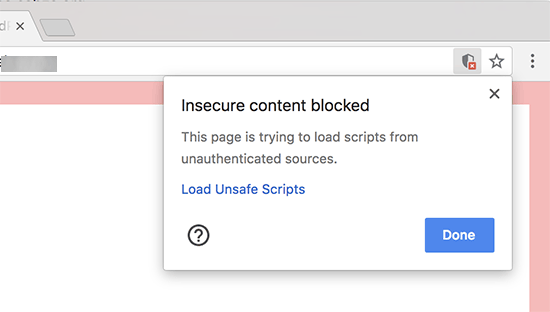
Mit dem Tool Inspect können Sie herausfinden, welche Inhalte über ein unsicheres Protokoll bereitgestellt werden.
Der Fehler bei gemischten Inhalten wird als Warnung in der Konsole angezeigt, mit Details für jedes Element mit gemischten Inhalten.

Sie werden feststellen, dass die meisten URLs Bilder, Iframes und Galerien sind, während einige Skripte und Stylesheets sind, die von Ihren WordPress Plugins und Themes geladen werden.
Reparieren von gemischten Inhalten in der WordPress-Datenbank
Die meisten der falschen URLs sind Bilder, Dateien, Einbettungen und andere Daten, die in Ihrer WordPress-Datenbank gespeichert sind. Lassen Sie uns diese zuerst beheben.
Am besten wäre es, wenn Sie alle Erwähnungen Ihrer alten Website-URL in der Datenbank finden, die mit HTTP beginnen, und sie durch Ihre neue Website-URL ersetzen, die mit HTTPS beginnt.
Sie können dies ganz einfach tun, indem Sie das Plugin ” Search & Replace Everything ” installieren und aktivieren. Weitere Details finden Sie in unserer Schritt-für-Schritt-Anleitung für die Installation eines WordPress Plugins.
Nach der Aktivierung müssen Sie die Seite Werkzeuge ” WP Search & Replace besuchen. Unter dem Feld “Suchen” müssen Sie die URL Ihrer Website mit http eingeben. Danach fügen Sie unter dem Feld “Ersetzen” die URL Ihrer Website mit https hinzu.

Darunter sehen Sie alle Ihre WordPress-Datenbanktabellen.
Sie müssen alle auswählen, um eine gründliche Prüfung durchzuführen.

Klicken Sie dann auf die Schaltfläche “Vorschau Suchen & Ersetzen”, um alle Änderungen zu sehen, die das Plugin vornehmen wird.
Klicken Sie abschließend auf die Schaltfläche “Alle ersetzen”.
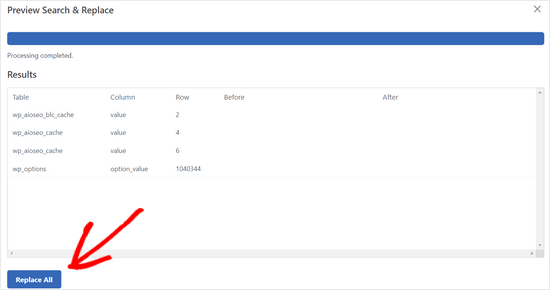
Das Plugin durchsucht nun Ihre WordPress-Datenbank nach den URLs, die mit http beginnen, und ersetzt sie durch sichere https-URLs. Je nach Größe Ihrer WordPress-Datenbank kann dies eine Weile dauern.
Fehler bei gemischten Inhalten im WordPress-Theme beheben
Ein weiterer häufiger Grund für Fehler bei gemischten Inhalten ist Ihr WordPress-Theme. Jedes anständige WordPress-Theme, das den WordPress-Codierungsstandards entspricht, wird dieses Problem nicht verursachen.
Zunächst müssen Sie das Inspektionstool Ihres Browsers verwenden, um die Ressourcen zu finden und festzustellen, von wo sie geladen werden.

Danach müssen Sie sie in Ihrem WordPress-Theme finden und durch https ersetzen. Dies wird für die meisten Anfänger etwas schwierig sein, da Sie nicht sehen können, welche Theme-Dateien diese URLs enthalten.
Behebung von Fehlern bei gemischten Inhalten, die durch Plugins verursacht werden
Einige Mixed-Content-Ressourcen werden von WordPress-Plugins geladen. Jedes WordPress-Plugin, das die WordPress-Codierungsstandards einhält, verursacht keine Mixed-Content-Fehler.
Wir raten davon ab, WordPress Plugins zu bearbeiten. Stattdessen sollten Sie den Autor des Plugins kontaktieren und ihm Bescheid geben. Wenn dieser nicht antwortet oder nicht in der Lage ist, das Problem zu beheben, sollten Sie eine geeignete Alternative finden.
Hinweis: Wenn aus irgendeinem Grund immer noch ein Fehler bei gemischten Inhalten auftritt, empfehlen wir die vorübergehende Verwendung des Really Simple SSL Plugins, damit Ihre Benutzer nicht beeinträchtigt werden, während Sie das Problem auf einer Staging-Website beheben oder einen Entwickler beauftragen.
Melden Sie Ihre HTTPS-Website bei Google Search Console an
Suchmaschinen wie Google betrachten https und http als zwei unterschiedliche Websites. Um SEO-Probleme zu vermeiden, müssen Sie Google mitteilen, dass Ihre Website umgezogen ist.
Dazu müssen Sie nur in Ihr Google Search Console-Konto gehen und auf die Schaltfläche “Eigenschaft hinzufügen” klicken.

Daraufhin wird ein Popup-Fenster angezeigt, in dem Sie die neue https-Adresse Ihrer Website eingeben müssen.
Es gibt zwei Methoden zur Überprüfung von Websites: Domänenname oder URL-Präfix. Wir empfehlen die Methode mit dem URL-Präfix, weil sie flexibler ist.
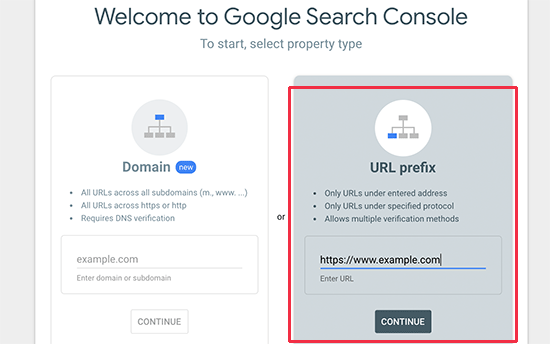
Danach werden Sie von Google aufgefordert, die Eigentumsrechte an Ihrer Website zu bestätigen.
Es gibt mehrere Möglichkeiten, dies zu tun. Wählen Sie eine Methode aus, und Sie erhalten Anweisungen zur Überprüfung Ihrer Website. Wir empfehlen die Verwendung der HTML-Tag-Methode.
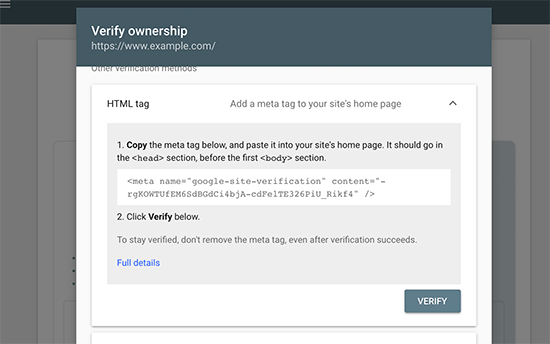
Sie sehen nun ein HTML-Code-Snippet, das Sie in den Head-Abschnitt Ihrer WordPress-Website einfügen müssen.
Search Console-Verifizierungscode mit All in One SEO hinzufügen
Installieren und aktivieren Sie zunächst das All in One SEO for WordPress-Plugin. Weitere Einzelheiten finden Sie in unserer Anleitung zur Installation eines WordPress-Plugins.
Hinweis: Es gibt auch eine kostenlose Version von All in One SEO, die Sie ausprobieren können.
Gehen Sie nach der Aktivierung auf die Seite All in One SEO ” Allgemeine Einstellungen und klicken Sie auf Google Search Console.

Darunter müssen Sie den Verifizierungscode hinzufügen, den Sie zuvor von der Google Search Console-Website kopiert haben.
Vergessen Sie nicht, auf den Button “Änderungen speichern” zu klicken, um Ihre Einstellungen zu speichern.
Wechseln Sie dann wieder zum Tab Google Search Console und klicken Sie auf den Button “Überprüfen”.

Sobald Ihre Website verifiziert ist, zeigt Google hier Ihre Search Console-Berichte an.
Sie müssen auch sicherstellen, dass sowohl die https- als auch die http-Version zu Ihrer Search Console hinzugefügt werden.
Damit teilen Sie Google mit, dass die https-Version Ihrer Website als die primäre Version behandelt werden soll. In Kombination mit den zuvor eingerichteten 301-Weiterleitungen wird Google Ihre Suchrankings auf die https-Version Ihrer Website übertragen, und Sie werden höchstwahrscheinlich Verbesserungen in Ihren Suchrankings feststellen.
Bonus-Ressourcen
Im Folgenden finden Sie einige zusätzliche Ressourcen, die Ihnen helfen können, häufige WordPress-Probleme selbst zu beheben und mehr über WordPress zu erfahren:
- Behebung häufiger SSL-Probleme in WordPress (Anleitung für Anfänger)
- Die häufigsten WordPress-Fehler und wie man sie behebt
- TLS vs. SSL: Welches Protokoll sollten Sie für WordPress verwenden?
- Wie man den Fehler der sicheren Verbindung in WordPress behebt
Video-Anleitung
Wir hoffen, dass dieser Artikel Ihnen geholfen hat, HTTPS und SSL in WordPress hinzuzufügen. Vielleicht interessiert Sie auch unser ultimativer WordPress-Sicherheitsleitfaden mit Schritt-für-Schritt-Anweisungen, um Ihre WordPress-Site sicher zu halten, oder wie Sie Ihr SSL-Zertifikat erneuern können.
Wenn Ihnen dieser Artikel gefallen hat, dann abonnieren Sie bitte unseren YouTube-Kanal für WordPress-Videotutorials. Sie können uns auch auf Twitter und Facebook finden.





Yasir
Is this plugin is secured.
WPBeginner Support
Yes, the plugin should currently be secured.
Admin
ammar
Hi, if i’m using the 1st method, do I need to follow the Submit my HTTPS Site to Google Search Console step also after that?
TQ
WPBeginner Support
Yes, you would still want to follow that step
Admin
Swen
I installed the Really Simple SSL plugin, which states that you should manually replace every http:// in all .css and .js files to //. That doesn’t sound really simple to me. As a beginner I set up a simple website with a couple of pictures. Is it common that http:// statements are in these files?
WPBeginner Support
Normally those links are not common so it shouldn’t be something to worry about.
Admin
Lucas
Hi,
When adding the code to .htaccess, i get a “too many redirects” error. I tryed adding to the existing code above, below, and also erasing the existing code and using only the new. All three option get too many redirects.
Is there something I should change there? Thanks in advance for your help!
WPBeginner Support
You would want to try some of the suggestions in our article here:
https://www.wpbeginner.com/wp-tutorials/how-to-fix-error-too-many-redirects-issue-in-wordpress/
for resolving the too many redirects and should those recommendations not work, you would want to check with your hosting provider to ensure they do not have a system that needs to be modified to point to the https version of your site.
Admin
Sotir Sotirov
I’ve tried using the plugin but when I do the website becomes not accessible. I’ve tried the manual approach but once I’ve changed the addresses in WP settings the site becomes not accessible again.
WPBeginner Support
You would want to reach out to your hosting provider to ensure that your SSL certificate is connected to your domain correctly and they should be able to help
Admin
Mike Ashworth
I am about to make the change to SSL and will be following the guidance in te article, initially using the really simple ssl plugin. Before i begin i have a quick question.
If I use the really simple ssl plugin, which takes care of everything, i can leave the general settings in wordpress for wordpress address and site address as http rather than change to https as the plugin will be taking care of it?
WPBeginner Support
Correct
Admin
Mike Ashworth
Thanks for confirming. I have one other rquestion.
having just activated lets encrypt ssl on siteground for a website, i am asked wther i want to switch the following on or leave it off.
HTTPS Enforce – Forces your site to work entirely over an encrypted HTTPS connection. The redirect is performed on server level and works for any website.
Do i leave this off as the really simple ssl plugin will take care of this as well?
WPBeginner Support
Yes, you can leave that off, you would only want to use that should there be any issues with the plugin or Google finding http links
Mike Ashworth
Thanks for your advice. WP Beginner is such an awesome website. Keep up the great work!
stephan
I want to thank you a lot. I have been looking for the errors over 12hours and get it done with better replace plugins. Thanks a lot dear.
WPBeginner Support
Glad our recommendation could help you
Admin
Arlina
Does adding in the plugin of SSL slow down my blog speed performance?
WPBeginner Support
It shouldn’t slow your site down
Admin
Peter Wilson
Can someone tell me, do I replace the contents on my.htaccess. file with the suggested code or do I place it and the beginning/end of the eisting entry.
WPBeginner Support
You would add it at the end of the current code in your htaccess file.
Admin
Peter Wilson
Thanks for the quick reply. So, would that be after the existing and before the # END WordPress, or does it go after the .
WPBeginner Support
That should not matter, it may be a good idea to do it after should you need to remove the code in the future
Shivanandana
Really awesome guide. Thank you so much! Thanks again for this detailed post!
WPBeginner Support
Glad you like our content
Admin
Håkan
Great content, helped me alot!
WPBeginner Support
Thank you, glad our content was helpful
Admin
Harsha
Very useful guide, thank you very much!
WPBeginner Support
You’re welcome, glad our article was helpful
Admin
Jan-Peter Molenaar
Thanks a lot!! Valuable content
WPBeginner Support
You’re welcome, glad our content is helpful
Admin
Greg
This article was so helpful. Thank you so much! Made it very easy.
WPBeginner Support
You’re welcome, glad our article was helpful
Admin
Nel
Most helpful guide ever. Thank you for this.
WPBeginner Support
You’re welcome
Admin
Jessica Quadra
This was so helpful and each step worked perfectly. Thank you!!
WPBeginner Support
You’re welcome, glad our guide could help
Admin
Hassen Loukil
Hi!
Thanks for the article!
What about google analytics? Same thing as Google search console or not?
WPBeginner Support
For Google Analytics you should be able to update to https under your property settings
Admin
Arif Ahmed
When I enable “WordPress 301 redirection to SSL” option from “Really Simple SSL Plugin” it works fine, but it removes query parameters. For example, when I get users from Adwords campaign it strips off gclid parameters.
Please guide
WPBeginner Support
You would want to reach out to Really Simple SSL’s support to see if there is an option for query strings.
Admin
Oswald Porter
Thanks for your helpful article.
The manual SSL/HTTPS set up seems be be working for the main site.
However the mixed content error (images) still appears after using the Better Search Replace plug-in.
At Media Library, images appear with ‘https’, but not at the site’s each post
Indeed, at all posts, when I right-click on the post image > ‘Copy image address’, it shows:
http://
Ideas? Thanks in advance.
WPBeginner Support
You would want to start by clearing any caching on your site and if that doesn’t work you could try the velvet blues plugin from our article: https://www.wpbeginner.com/plugins/how-to-update-urls-when-moving-your-wordpress-site/
Admin
Kathy
Hi,
I used this tutorial on many sites and it works like a charm. Thanks for that.
Do you know if I can also use it to update my multisite(s). Or are additional steps needed?
WPBeginner Support
Depending on how your multisite is set up there are normally more steps involved. If you reach out to your hosting provider they can normally help
Admin
Ralph
Thanks, very nice tutorial.
WPBeginner Support
Thanks, glad you liked our guide
Admin
Oz
Fantastic and straightforward!
What steps do we need to take to make sure our social share count (e.g., Facebook, Twitter) are still available?
WPBeginner Support
You could try 301 redirecting the http articles to https but unless I hear otherwise, social media sites see the two as different links so you are likely going to lose your shares unless they have added a method to update your share counts.
Admin
Ahsan
I used cloudflare for free SSL but my traffic has dropped 25%. Is this due to cloudflare?
WPBeginner Support
There are multiple possible reasons for a change in traffic so it is hard to say if that is the only reason or if there were other reasons for a drop in traffic.
Admin
Shawn
Thank you for such a great piece of content.
It seems like using the Really Simple SSL plugin is way easier than changing codes and scripts on my own.
My question – what if the plugin did not get updated in the future? Is this going to cause a problem for our urls?
And, after installing the SSL from my web host, all I need to do is to activate Really Simple SSL plugin and everything will be redirected to https?
Shawn
WPBeginner Support
It would depend on what changes in WordPress’ core code and how long it has not been updated for the possible issues. The plugin should automatically update your content that it is able to use HTTPS without you needing to modify anything on your end if you wanted.
Admin
Nathaniel
Just wanted to say thank you. I was not looking forward to doing this, but you’re guide made it easy and quick. Thanks!!!
WPBeginner Support
Glad our guide could help
Admin
Sheri Ellis
I made the mistake of following your manual instructions before our SSL cert had been installed. All I did was edit the general settings for the URL to https. And now the site is hosed. I’ve been editing every PHP file to include:
define( ‘WP_HOME’, ‘http://mysite.com’ );
define( ‘WP_SITEURL’, ‘http://mysite.com’ );
and it’s being ignored. So now my site is hosed. FYI I’m using WordPress 5.1.1 which appears to have significant changes. Help!
WPBeginner Support
You should be able to edit the url back using phpMyAdmin similar to our article here: https://www.wpbeginner.com/beginners-guide/how-to-reset-a-wordpress-password-from-phpmyadmin/
and edit the options table rather than the users table.
Admin
Sheri Ellis
Thanks for the response but it didn’t work. I ran mysql command line to update the wp_options table and set option_value to http where option_name in (‘home’,’siteurl’). I have also inserted the define HOME and SITEURL commands into many PHP files including wp-config.php, and also added define( ‘RELOCATE’, true );
Still hosed. Appreciate any additional suggestions!
WPBeginner Support
You may want to ensure if you have a caching plugin that you disable it, as you are unable to log into the site you could use: https://www.wpbeginner.com/plugins/how-to-deactivate-all-plugins-when-not-able-to-access-wp-admin/
otherwise, if you reach out to your hosting provider they should be able to assist
Sheri Ellis
Had tried that as well, with no luck. I had to blow away the entire site and reinstall WP. But appreciate the effort!
John J Cooke
This made making the switch a snap. I was sitting on the ssl cert with no sure way how to convert. Really appreciate the easy instructions.
WPBeginner Support
Glad we could make the process easier for you
Admin
Mandee
Oh my goodness, THANK YOU! I’ve reached out to my hosting company, as well as a developer. They both made it seem like an impossible task to do on my own. Just took care of this is literally 30 seconds because of you. I can’t thank you enough! I wish I would have found this article sooner—would have saved me a lot of headache!!
WPBeginner Support
Glad our article could help
Admin
Jerry
Hi,
I tried twice your step guide end everything worked great. Now that i have SSL i am trying to migrate but there is a problem on the final step, so it cannot be finalized. Is it a problem i had Lets Encrypt on old server and now that the new one has another, to have caused a problem. Would you recommend remove SSL on old hosting and after that using dublicator to start the articles process?
WPBeginner Support
Who has your SSL should not be a factor for it not working, you could try to see if that works but it is normally due to another cause.
Admin
BILAL ALI AHMAD
Hi,
I applied all steps and https version is working fine on my website but the non-https version is still accessible when I type http: mysite.com
how to resolve this issue?
Also when I click on my google search link for my website user also lands on non-https version and after that if I access the website again it comes with https
please tell me how to resolve this issue?
WPBeginner Support
If you already submitted your site to Google’s Search console then Google may have cached the http version in their search. For the http version being available, you may want to ensure the redirects were all saved.
Admin
Clement
This was surprisingly simple that’s why I rely on you guys, had actually thought it would be horrible.
WPBeginner Support
Glad our guide could make it easy for you
Admin
Marc-Lyon
Thanks for the great tutorial. Only issue I’m stuck with is that URLs with www appended give an error message in browser:
“This site can’t provide a secure connection uses an unsupported protocol.
ERR_SSL_VERSION_OR_CIPHER_MISMATCH
Unsupported protocol
The client and server don’t support a common SSL protocol version or cipher suite.”
I’ve checked and both non-www and www versions have valid SSL certificates. Any idea why the www version is not working?
WPBeginner Support
Start by reaching out to your hosting provider to ensure they don’t have a setting on their end for the www specific version of your site.
Admin
Marc-Lyon
Managed to sort it out. Cloudflare was causing the issue.
Solution: disable and re-enable Universal SSL under Crypto settings.
WPBeginner Support
Glad you were able to find the cause and thanks for sharing the solution should anyone else run into the issue
Rock
Very helpful blog. Thanks.
WPBeginner Support
You’re welcome
Admin
illy
All my images were inserted with http protocol. I used Better Search Replace to fix this and it worked like a charm!
thank you
WPBeginner Support
Glad our recommendation could help
Admin
Didier
I have a problem with the redirect from http to https.
Using the above mentioned code in the .htaccess file,
my index page http:// example.com redirects to httpS:// example.com
BUT
A subpage http:// example.com/sublink does NOT redirect to https:// example.com/sublink
Does anybody know how to solve this?
Thank you!
WPBeginner Support
You may want to reach out to your hosting provider to ensure they are not overriding any redirects on your site or if they see the code was copied incorrectly.
Admin
Jason
Yeeeeeeeeeeeeeeeeeeeeeeeeeeeeeeeees! The first WP edit that has ever worked first time for me! I’m taking the rest of day off to celebrate.
WPBeginner Support
Glad our guide could help
Admin
Leo Al
Thanks a lot!
It worked
WPBeginner Support
Glad our article could help
Admin
Igor N
Thanks, that was really helpful. I went with the method 2 and everything was just fine.
WPBeginner Support
Glad our tutorial could help and you got it working
Admin
Pamela
This detailed article saved a beginner like me! So helpful. Thank you very much.
WPBeginner Support
Glad our guide could be helpful
Admin
Rafaqat Ali
Hi thanks for the article, I have shifted my site to ssl by using the article elaborated above.
Let me clear a few things:
1- I have added a new property in Google search console with https:// should I delete the http:// property or remain the both.
2- How long it will take to show google search data in the search console report.
3- Should I make a 301 redirect to https:// version.
4- How to get all my backlinks to https:// version.
( i have submitted the XML sitemap and robots..txt file also with new property)
Thanks for your time
WPBeginner Support
Hey Rafaqat,
If you have set up 301 redirect to your HTTPS urls, then you can leave them both. They would start appearing in search very soon, however of your redirects are properly setup you wont see any difference in your traffic or search rankings.
Admin
Belinda
Thankyou so so much, this article helped me fix both my blog and online store.
Roberto
It is an amazing article, I solve my problem and now I have my site up and running. Thanks so much!
Editorial Staff
You’re very welcome Roberto
Admin
Eva
Hi and thank you for the detailed tutorial
I have activated the ssl protocol on a new wordpress installation and after the activation the site’s started opening with https and green padlock ( all pages, with and without www search and if searching http version) even the admin area as far as the theme and editor , however the wordpress and site URL fields in the settings General page still need to be changed to https as they appear as http and any new publication (so as the ones alredy been there) has http link and when editong page appearancefrom main menu it shows exclamation mark oven the secure connection padlock
In that case do I need to go thru all process or after updating the general settings page to https it will be ok ?
It’s my first time doing that and I prefer ( if have to) to do it manually by the 2 method as it very well explained
Thanks
WPBeginner Support
Hi Eva,
You can try the second method or follow the instructions in the first method. You will need to change the URLs in settings as it tells WordPress to use https in URLs.
Admin
Bernard Brillo
I’ve tried following the manual tutorial but I end up seeing a blank white page on my homepage and all of my other page are now inaccessible. My website is hosted in Amazon and I’m also using W3 total cache.
Do I need to do something else to make this work?
Any suggestions will be much appreciated.
Donatas Vaiciulis
On my website was W3 total cache, when I disabled it worked everything fine. I think after htaccess edit needed to reinstall plugin and do w3 settings again. Not tried yet, soon will try.
Josh
I did method 1 and it worked perfectly. Thanks so much for the tutorial!
Karo Itoje
Hello,
As usual thanks for the detailed tutorial. I decided to do the manual option (option 2) because it seemed simple enough to follow through. However when I pasted the second code for nginx servers into configuration file (wp-config.php) I got a syntax error. So I had to remove the code. But I will still like to follow through with that option so if you can please maybe take a look at that code again and correct it then I’ll really appreciate it.
Also just to get this clearly, it is either:
“set up WordPress redirects from HTTP to HTTPS by adding the following code to your .htaccess file.”
OR THIS
“If you are on nginx servers (most users are not), then you would need to add the following code to redirect from HTTP to HTTPS in your configuration file:”
Not both right?
mostafa elaissaoui
thank u
realy you help me thank you
Rohan Kothari
Hi,
I am planning to start an e-commerce store. Do I need to purchase a wildcard SSL certificate and a dedicated IP to enable payments on my website or will the free SSL certificate bundled with web hosting plans be adequate?
Oliver
Hi Guys,
1st off a great and helpful article, thanks. I have changed my site from http to https and it took a lot less time than I expected, using the Better Search and Replace manual method. But now I can’t seem to change the address of the http version in the Google Search Console. It has both of the sites there but won’t allow me to swap. Is this necessary to do? It seems as if the redirects are working. Should I get the https site indexed as much as possible or will google do that with the http redirects anyway?
WPBeginner Support
Hi Oliver,
If you have both sites in the search console and a redirect in place, then Google will automatically detect the transition and will start showing reports for your HTTPS site.
Admin
Victor Fernando
I used the first method, although I have experience in programming, I don’t have it in wordpress and I don’t dare to get my hands on the code even though it’s not that complicated.
the first method worked i.e. installing the free plugin version.
Thanks for the tip